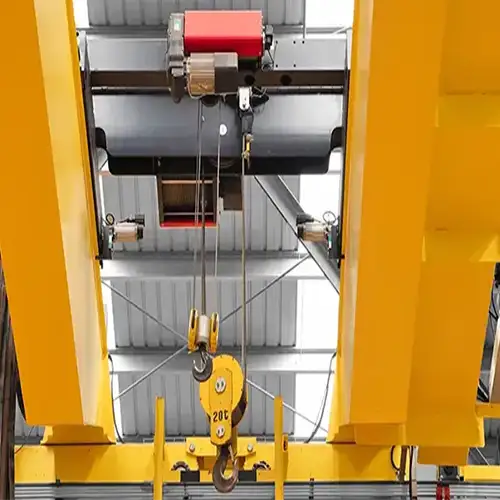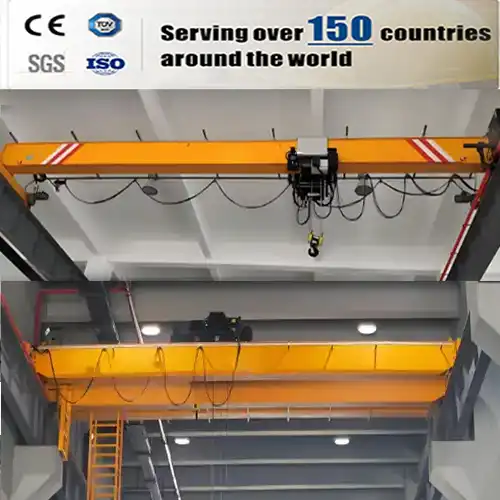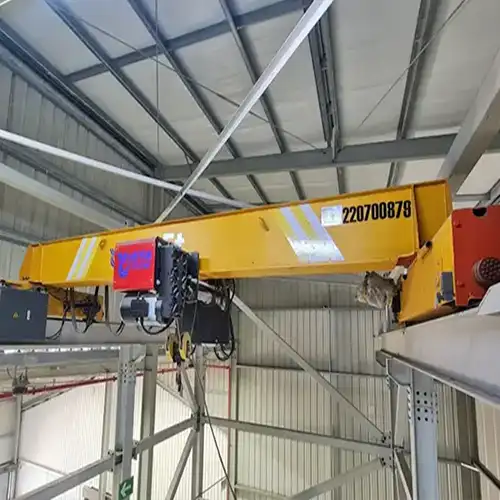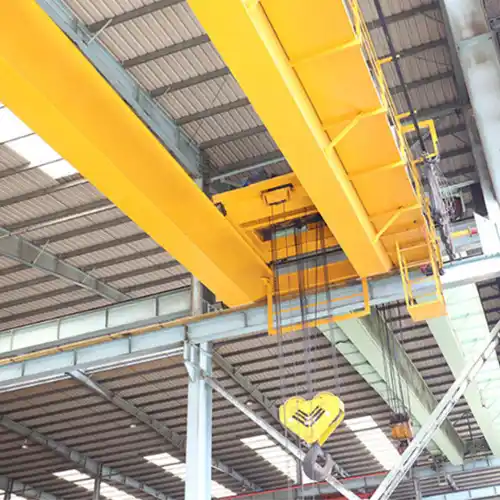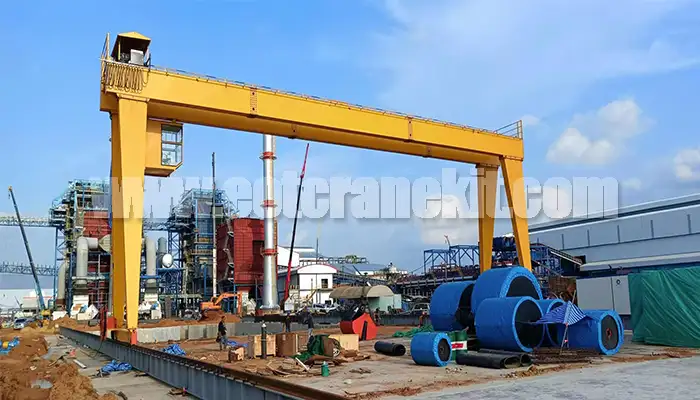
10 Ton Double Girder Gantry Crane Installation in Thailand
10 Ton Double Girder Gantry Crane Installation in Thailand
Gantry cranes are essential in many industrial applications, especially for heavy lifting tasks. They consist of a frame that supports a hoist, allowing it to move along a track. This design provides flexibility and efficiency, making gantry cranes a go-to choice for projects that require reliable lifting solutions.
In Thailand, the installation of a gantry crane is not just a technical task; it signifies growth and development. This project will enhance operational capacity in local industries, showcasing Thailand's commitment to modernizing its infrastructure. It's an exciting time for everyone involved!
The 10 Ton Double Girder Gantry Crane is a robust piece of equipment designed for heavy-duty applications. Its double girder configuration offers greater stability and lifting capacity, allowing it to handle large loads with ease. This crane is particularly well-suited for construction sites, warehouses, and manufacturing facilities.
Located in a strategic area, this project site is pivotal for both local industry and trade. The installation of the crane here will streamline operations, reduce downtime, and increase overall productivity. Plus, it's a real game-changer for the workforce, enhancing safety and efficiency in lifting tasks. By investing in this technology, we're not just upgrading equipment; we're investing in the future.
Crane Specifications
The Double Girder Gantry Crane is engineered for strength and versatility, making it ideal for various industrial applications. With a lifting capacity of 10 tons, it can handle substantial loads, providing a reliable solution for heavy lifting tasks.
The crane boasts a generous span of 27 meters, allowing it to cover extensive work areas efficiently. This wide reach is crucial for operations in larger facilities where space is often at a premium. The lifting height of 10 meters further enhances its functionality, enabling operators to work on tall structures or stack materials effectively.
Equipped with a clamshell grab bucket as the below hook device, this crane excels in handling bulk materials. This attachment allows for quick and efficient loading and unloading, making it a practical choice for construction and waste management. With these specifications, the crane is set to optimize workflows and improve productivity on-site.
- Crane Type: Double Girder Gantry Crane
- Crane Capacity: 10 Tons
- Crane Span: 27 Meters
- Lifting Height: 10 Meters
- Below Hook Device: Clamshell Grab Bucket
Object Handling of Clamshell Grab Bucket
Description of the Material: Sugarcane Ash
Sugarcane ash is a byproduct of burning sugarcane waste, often utilized in various applications, including soil amendment and construction materials. Its lightweight, granular nature makes it easier to handle compared to heavier materials, yet it still poses unique challenges due to its fine particles and dustiness.
Handling Requirements and Challenges
When dealing with sugarcane ash, precise handling is crucial. The crane must manage the bulk material efficiently, minimizing spillage and ensuring safe transport. Given the ash's tendency to create dust, operators should be equipped with dust suppression systems to maintain a safe working environment.
Additionally, the crane's lifting attachments, like the clamshell grab bucket, need to be designed specifically for handling lightweight, flowable materials. This ensures a secure grip without the risk of damaging the ash during transport. Operators should also be trained to handle potential challenges, such as the material's propensity to clump or shift during movement. With the right strategies, the process can be both effective and safe.
Essential Steps for Receiving and Unpacking Equipment
To ensure a smooth installation process, it is vital to handle equipment delivery with care. The following key points outline the responsibilities of both crane suppliers and buyers in various scenarios.
Packaging and Labeling:Proper packaging and labeling are crucial for an efficient unpacking process. Suppliers should securely package each box using dividers to prevent movement during transport. Clear labels with part numbers and descriptions should be included to facilitate easy identification upon arrival. On the other hand, buyers must verify the presence and condition of all boxes as soon as they are received, using the labels as a guide. This step ensures accountability and aids in tracking all components.
Documentation:Documentation plays a critical role in the receipt of equipment. Suppliers should provide detailed documentation, including a packing list and specifications for each box. This information helps buyers understand what to expect and facilitates any future claims. Once the shipment is received, buyers should take detailed photos of each box and its contents for their records. These photos serve as documentation in case of discrepancies or damages and can support warranty claims if needed.
Consulting the Installation Engineer:The involvement of an installation engineer can significantly impact the setup process. If installation is included in the purchase contract, suppliers are responsible for designating a qualified engineer who will oversee the installation. This engineer should arrive on-site promptly to ensure everything is set up correctly. For buyers, if the supplier's engineer is available, it is best to wait for their arrival before proceeding with unpacking. However, if the installation will be handled by the buyer's own engineer, it's essential to ensure that the engineer is well-informed about the equipment and its specifications.
Handling Large vs. Small Items:Effective handling of both large and small items is necessary for a successful installation. Suppliers should ensure that large items are packed securely to prevent damage during transport and provide specific instructions for handling small parts, which are more prone to loss. Buyers, meanwhile, must maintain an inventory list of all received items, paying particular attention to small components. By organizing and counting items immediately upon arrival, buyers can quickly identify any missing parts.
Careful Unpacking: The unpacking process requires attention to detail. Suppliers should provide clear unpacking instructions, including any necessary tools or procedures to safely remove items from their packaging. Buyers should unpack slowly and methodically, ensuring that small components are placed in designated areas to prevent loss. Additionally, preparing the workspace and tools ahead of time will help ensure that everything is ready for a smooth installation.
By clearly defining these responsibilities, both suppliers and buyers can work collaboratively to ensure an efficient installation process, minimizing potential issues and promoting a successful outcome.
Installation Process
Pre-installation Site Assessment
Before the installation of the gantry crane, a thorough site assessment is essential. This involves evaluating the location's structural integrity, assessing ground conditions, and identifying any potential obstacles, such as overhead power lines or nearby buildings. It's also vital to check for proper drainage to prevent water accumulation around the crane's base. A well-planned assessment lays the groundwork for a smooth installation and helps avoid unexpected challenges down the line.
- Structural Integrity: Assess the existing structures at the site to determine their ability to support the crane's weight and operational stresses. This includes examining foundations, nearby buildings, and any other infrastructure that may affect crane stability.
- Ground Conditions: Evaluate the soil type and ground conditions where the crane will be placed. Ensure the ground can adequately support the crane's load without settling or shifting. Geotechnical surveys may be necessary in some cases.
- Potential Obstacles: Identify any potential obstacles in the vicinity, such as overhead power lines, trees, or nearby buildings, that could interfere with crane operation. Ensuring ample clearance is critical for safe lifting and maneuvering.
- Drainage Considerations: Check for proper drainage around the crane's base to prevent water accumulation. Poor drainage can lead to structural issues and operational hazards over time.
A well-planned assessment lays the groundwork for a smooth installation, helping to avoid unexpected challenges and ensuring the crane operates efficiently and safely.
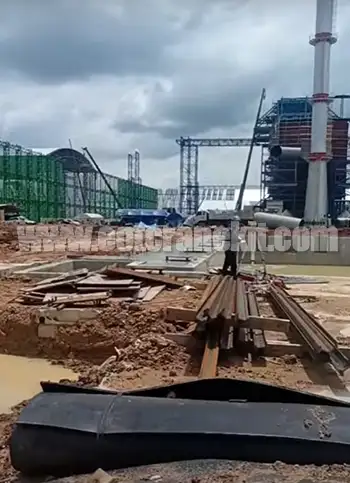
application environment of double girder gantry crane 10 ton
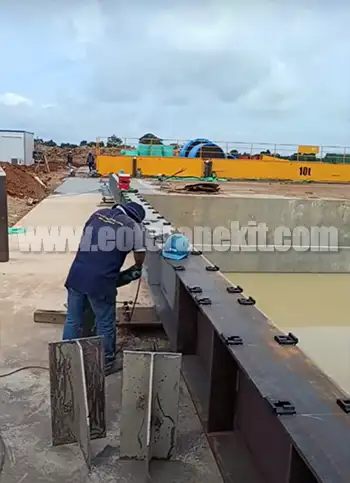
rail foundation of double girder goliath gantry crane
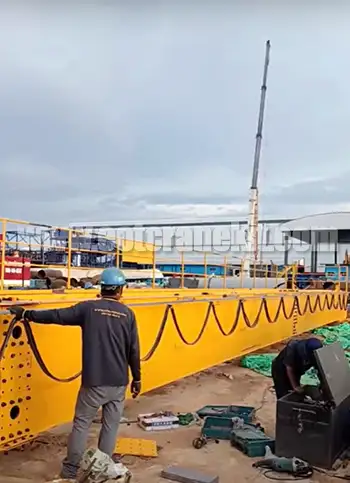
Main parts and components of 10 ton double girder gantry crane
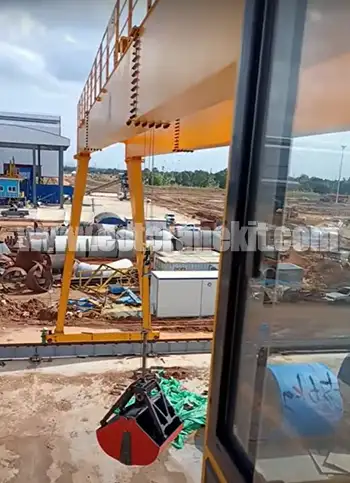
sucessful installation of double girder gantry crane with clamshell grab bucket
Key Steps in the Installation Process
1. Foundation Preparation
The foundation preparation is the critical first step in installing a gantry crane. This involves creating a robust concrete base that meets the specific load requirements of the crane. It is essential to ensure that the foundation is both level and stable. To achieve this, detailed engineering calculations should be performed to determine the appropriate size and depth of the concrete pour, considering the crane's weight and operational stresses. During this phase, proper curing time for the concrete must also be observed, as insufficient curing can lead to structural weaknesses that compromise the crane's performance. Additionally, soil conditions should be assessed to confirm that the ground can adequately support the foundation.
2. Assembly of Crane Components
Once the foundation is ready, the next step involves the assembly of the crane components on-site. This process typically includes heavy parts such as the girders, hoist, and wheels. Given the significant weight of these components, cranes or forklifts are usually employed to lift and position them with precision. Each part must be carefully inspected for quality and compatibility before assembly. Fastening methods, such as welding or bolting, must be executed according to industry standards to ensure the structural integrity of the crane. Proper alignment during this stage is crucial, as any misalignment can lead to operational inefficiencies and safety hazards.
3. Installation of the Gantry Structure
With the individual components assembled, the next step is the installation of the double girder framework. This framework is positioned on the prepared foundation, requiring precise alignment to ensure optimal operation. The installation process may involve the use of leveling tools to confirm that the structure is perfectly horizontal and aligned with any predetermined tracks or guide rails. Attention to detail during this phase is critical, as proper alignment affects not only the crane's performance but also its safety during operation. Any discrepancies should be corrected immediately to avoid complications in future operations.
4. Electrical and Safety Systems Setup
After the physical structure is established, the installation of electrical systems comes next. This includes wiring controls, integrating safety features, and connecting power supplies. Key electrical components include control panels, limit switches, and emergency stop systems, which are vital for safe crane operation. The setup should follow local electrical codes and standards to ensure safety and compliance. Testing the electrical systems at this stage is crucial, as it verifies that all safety measures function properly and that the crane can respond effectively during operation. This phase may also involve programming the crane's control systems to meet specific operational requirements.
5. Final Inspection and Testing
Once all components are assembled and the electrical systems are installed, a thorough inspection and testing phase is conducted. This involves a comprehensive review of all mechanical and electrical components, ensuring that the hoisting mechanism operates smoothly and that all controls function correctly. Load tests are performed to confirm that the crane can safely handle its maximum capacity without issues. During these tests, it's important to monitor for any unusual noises, vibrations, or performance irregularities. Any issues identified during this phase must be addressed before the crane can be officially commissioned for operation. This final step ensures that the gantry crane is ready for reliable and safe service in its operational environment.
Completing these key steps with meticulous attention to detail not only enhances the efficiency of the gantry crane but also significantly improves safety for operators and surrounding personnel.
Safety Measures During Installation
Safety is paramount during the installation process. Here are some key measures to consider:
- Personal Protective Equipment (PPE): All personnel involved should wear appropriate PPE, including hard hats, gloves, and safety glasses, to protect against potential hazards.
- Clear Communication: Establish clear communication protocols among the installation team. Using hand signals or radios can help coordinate movements and ensure everyone is aware of the installation progress.
- Stability Checks: Throughout the installation, continuous monitoring of the crane's stability is vital. This includes checking the foundation and ensuring that no shifts occur during assembly.
- Emergency Preparedness: Having a plan in place for emergencies can mitigate risks. This includes having first aid kits on-site and ensuring that personnel are trained in emergency procedures.
By following these steps and safety measures, the installation process can proceed smoothly, setting the stage for successful crane operations in the future.
Benefits of the Installation
Enhanced Efficiency in Material Handling
The installation of the gantry crane significantly boosts efficiency in material handling. With its 10-ton capacity and clamshell grab bucket, the crane streamlines the process of lifting and transporting sugarcane ash. This efficiency reduces the time required for loading and unloading, leading to faster project completion. Furthermore, the precise control of the crane minimizes waste and spillage, ensuring that materials are handled safely and effectively. Overall, this improvement translates into increased productivity and cost savings for operations.
Contribution to Local Industry and Economy
Beyond operational benefits, this installation has a positive impact on the local industry and economy. By enhancing material handling capabilities, businesses can increase their output and improve service delivery. This, in turn, fosters growth in related sectors, creating job opportunities and supporting local suppliers. Additionally, a modernized facility attracts investment and can even lead to collaborations with other industries, further strengthening the regional economy. Ultimately, this installation is not just an upgrade; it's a catalyst for broader economic development in the area.
Conclusion
The installation of the 10-ton double girder gantry crane marks a pivotal advancement for the local industry in Thailand. By enhancing material handling capabilities, this project not only improves operational efficiency but also sets a benchmark for safety and productivity. The ability to handle sugarcane ash effectively is crucial for local businesses, ensuring they can meet increasing demand while minimizing waste and downtime. This crane installation is more than just equipment; it symbolizes a commitment to modernization and growth within the region.
